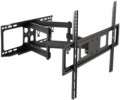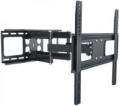Minimum size
The minimum TV screen size that can be mounted on the stand/mount. It is usually indicated for structures with mounts, for stands this parameter is irrelevant (for more details, see "Type"). The parameter is not absolutely accurate, because technically, TVs with a smaller size can fit the mount; however, in general, it allows to evaluate the scope of a particular model of mount/stand.
Max. size
The maximum size of the TV screen that can be installed on the stand/mount. Like the minimum size (see above), it is in some way a conditional indicator — TVs with a larger size can also fit for the mount, and then the main determining parameter will be the maximum weight (see below).
Adjustments
The ability to change the position of the TV installed on the mount. Adjustments make it possible to optimally adjust the location of the screen; the more there are adjustments, the wider the customization options.
—
For curved TVs. Stands designed for use with curved TVs. Such TVs are becoming increasingly popular — it is believed that the curved shape has a positive effect on the image quality. Note that the dimensions and curvature of such screens can be different, so the compatibility of the stand with a specific TV has to be clarified separately.
—
Tilt. The ability to adjust the tilt of the installed TV forward and backward relative to the vertical position. It will be useful if the TV is not installed at eye level, and also if the height of the audience changes (for example, if you are sitting on the sofa, then on the floor, depending on your mood).
—
Turn. The ability to turn the TV around a vertical axis, from side to side. This gives a certain freedom in moving around the room — by moving to another point, you can turn the TV in the right direction and watch comfortably.
—
Depth adjustment. The ability to move the TV back and forth relative to the point of attachment to the wall without changing the angle of the screen. Can be used in combination with turn — for example, if at a selected
...point in the room an object on the side of the TV is blocking it, the screen can be pulled out from behind the obstruction and turned for the optimal viewing angle.
— Slide. The ability to move the TV from side to side relative to the point of attachment to the wall without changing the angle of the screen. This can be useful, for example, when rearranging: by moving the TV to the side, you can install a piece of furniture next to it that did not fit there before, without rearranging the mount itself. It can also be used in conjunction with turn, similar to depth adjustment (see above).
— Rotation. The ability to rotate the installed monitor around the horizontal axis, in other words, the ability to rotate the screen from a horizontal position (“landscape” orientation) to a vertical (“portrait”) one. In everyday use, this function is practically not in demand, and therefore is rare. At the same time, it can be useful for specialized purposes — for example, if the screen is used as a monitor and you need to work with vertically stretched materials (graphics or texts).
— Height adjustment. The ability to adjust the height of the TV on the mount. Allows you to optimally adjust the position of the screen relative to eye level, surrounding objects, etc.Upward tilt angle
The maximum upwards tilt angle from the vertical of the installed screen. The larger the tilt angle, the wider the adjustment possibilities, however, in fact, an angle of more than 5° is rarely required.
Downward tilt angle
The maximum downward tilt angle from the vertical for the installed screen. As with the upward tilt angle, the larger this angle, the wider the adjustment possibilities; however, downward tilt is usually required more frequently (the TV may be installed under the ceiling), and its angle can be as high as 15-20°.
Rotation angle
The angle within which the screen installed on the mount can rotate. Rotation refers to turning around a horizontal axis perpendicular to the screen; see "Adjustments" for details. And the angle is usually indicated from one extreme position to another.
According to this parameter, two categories of mounts can be distinguished. In one of them, the rotation angle is small — about 10 – 15 ° — and this feature is mainly intended to compensate for inaccuracies made during the installation of the structure: even if the mount hangs slightly unevenly,
rotation allows you to set the screen straight. The second variety is models with a rotation angle of 180° and above (up to 360°); they allow user to rotate the screen from landscape to
portrait and vice versa.
VESA
VESA is generally accepted standard for most modern screens (TVs, monitors, plasma panels) and is found in all types of stands/mounts, except for classic stands (see "Type"), where the TV is placed on its own stand. Any such mount has 4 screws arranged in the shape of a rectangle (square). However, the size of this rectangle can be different, it depends primarily on the weight, and, accordingly, the size of the screen. The smallest mount today is
50x50 mm, it is designed for very miniature models;
100x100 mm can already hold TVs of about 24",
200x200 mm — 32", and in larger models, the size of the mount can reach
800x400 mm. Many mount/stand models have holes for several VESA standards.
The following sizes of VESA mounts are currently on the market:
50x50 mm,
75x75 mm,
100x100 mm,
100x200 mm,
200x100 mm,
200x200 mm,
200x300 mm,
200x400 mm,
300x200 mm,
300x300 mm,
300x400 mm,
400x200 mm ,
400x300 mm,
400x400 mm,
500x400 mm,
600x400 mm,
600x600 mm,
700x400 mm,
800x400 mm,
800x600 mm,
800x800 mm,
900x400 mm,
900x500 mm,
900x600 mm,
1000x500 mm,
1000x600 mm.
Cable management
Possibility
of placing the cables connected to the TV inside the rod or support of the mount(for ceiling and floor structures, respectively, see "Type"). This placement gives the whole structure a neat appearance, because cables, often of different sizes and colours, and even tangled with each other, are hidden from view and do not spoil the aesthetics.

